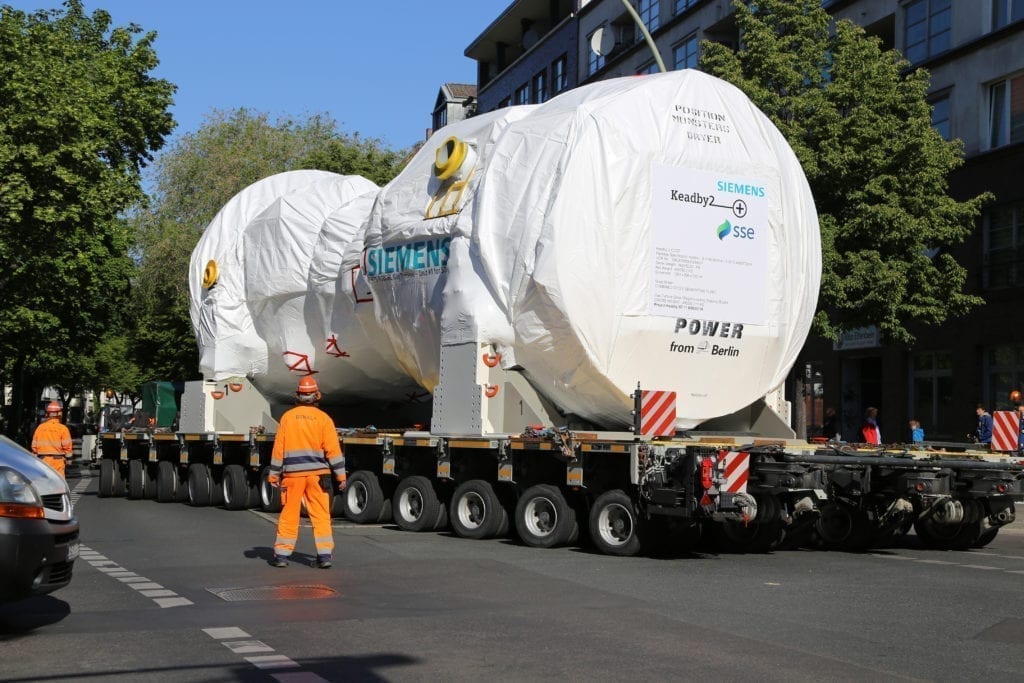Siemens Launches 'Most Powerful' HL-Class Gas Turbine
Siemens on May 15 began moving what the company calls its “largest, most powerful, and most efficient heavy-duty gas turbine” from Germany to the UK, where the company will test the equipment for use in a combined cycle power plant.
The SGT5-9000 HL turbine, built by Siemens Gas and Power in its Berlin factory, will provide the opportunity for a test run of the equipment for the 50-Hertz (Hz) market. The 593-MW capacity turbine will be installed at the Keadby 2 power plant for SSE Thermal. The plant is located in Lincolnshire.
A Siemens spokesperson on Friday said the cost of the turbine could not be disclosed. The spokesperson told POWER that “development, design and manufacturing of the turbine took four to five years.”
“We already sold seven HL-class engines (50 Hz + 60 Hz),” the spokesperson told POWER in an email. “Siemens HL-class is technically selected for several more projects. Negotiations for other projects are ongoing,” including in Europe and other continents. The spokesperson said “unfortunately, more details about these projects can’t be disclosed.”
Siemens recently achieved first fire of the first 60-Hz version of an HL-class turbine at Duke Energy’s Lincoln Combustion Turbine Station near Denver, North Carolina, on April 6.
The HL-class turbine’s debut comes as competitor General Electric (GE) also continues to upgrade its gas turbines. GE in October 2019 unveiled its 7HA.03, the newest model in its high-efficiency air-cooled gas turbine line. Siemens, GE, and Mitsubishi Hitachi Power Systems—soon to be renamed Mitsubishi Power—continue to vie for business in the competitive and ever-shrinking global gas turbine market.
The 50-Hz SGT5-9000 HL measures nearly 43 feet in length and is about 16.5 feet wide. It weighs almost 500 metric tons—a whopping 1.1 million pounds. An inland cargo ship began moving the turbine from Berlin on May 15. It will travel by inland waterways to the Port of Rotterdam in the Netherlands, where it will be loaded onto a ship for transport to England.
Siemens said the turbine will travel up the Humber and Trent rivers for about 12 days before reaching the inland port of Keadby. The turbine will then be offloaded and transported to the construction site using a heavy hauler.

Siemens said the unit after testing will be expanded into a combined cycle power plant, capable of generating 840 MW of power with a baseload efficiency of more than 63%.
“Shipping the first SGT5-9000HL gas turbine is an important milestone for the Keadby 2 project,” said Karim Amin, CEO of the Generation division within Siemens Energy, in a news release. “I’m pleased that we were able to complete the turbine assembly work during these challenging times, despite all the restrictions imposed by COVID-19, and that we managed to successfully send the machine off on its journey to the power plant location in the UK.”
Operation of the new turbine at the Keadby site is scheduled for next year, and SSE Thermal plans to place it into commercial operation in 2022, if the testing goes well. Siemens also is providing service with its first long-term program (LTP) for an HL-class gas turbine in Europe. The company said it “will utilize its advanced digital service solutions, including remote monitoring and diagnostics, to help maintain the availability, reliability and optimal performance of the power plant.”
Stephen Wheeler, managing director of SSE Thermal, said the start of moving the turbine from Germany “marks a hugely exciting milestone for our Keadby 2 project as the turbine begins its journey to north Lincolnshire. This first-of-a-kind technology will make Keadby 2 the UK’s cleanest and most efficient gas-fired power station, displacing older, more carbon-intensive generation, and providing vital flexibility for the electricity system.”
Siemens said the HL-class turbines will bring higher efficiencies to market by combining new, previously tested technologies and construction features with best practices from prior experience. The company said the higher efficiency of the HL-class will save fuel and also reduce emissions of carbon dioxide by as much as 3.7 million metric tons per year, compared to coal-fired power plants.
The Siemens spokesperson on Friday told POWER: “The Keadby project is a proof point that the decarbonization efforts in many markets worldwide take effect, and the process of coal replacement [has] already started. Large, flexible and highly efficient gas turbines like Siemens’ HL-class are the best match to backup and balance renewables. It would show that large heavy-duty gas turbines still play an important role in the energy mix, due to their superior efficiency, their short start-up times and ramp rates. They are an essential and cost-efficient solution for modern energy markets.”
—Darrell Proctor is associate editor for POWER (@DarrellProctor1, @POWERmagazine).